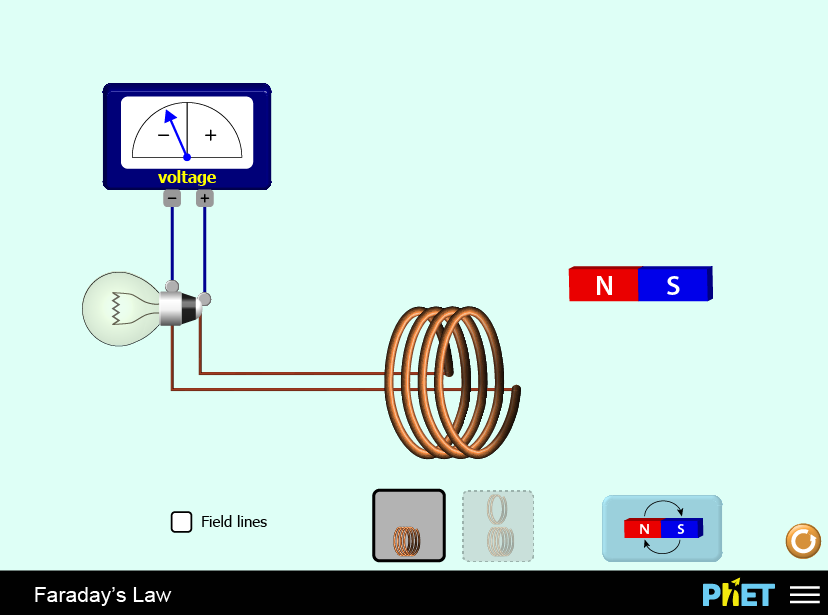PhET Faraday's Law Simulation
- Caren Watkins
- Jonathan Hung
Description of the Simulation
In the Faraday's Law simulation made by PhET, learners can move a magnet freely within the playing space. As the magnet moves near a coiled wire, an induced current is created in the wire which creates voltage through the circuit which is then measured by a voltmeter, and illuminates a light bulb.

Learning Outcomes
Speed and Flux
The magnetic fields that radiates from the North and South poles of the magnet is what causes the induced charge. The magnetic field crosses the coiled wire which creates flux. The faster the magnetic field is moved over the coil, the more flux is created. Flux is measured with a volt meter as an induced charge. The light bulb is there to illustrate the effect of the induced charge.
Alternating poles and current (advanced learning)
A more advanced topic is related to the flux caused by alternating the poles. By alternating poles you can:
- create flux
- change the "direction" of voltage as indicated by the voltage meter (this is called alternating current)
- the light bulb will light regardless of the direction of the current
Design Challenges
These are the major design challenges identified so far:
- Controlling the speed of the magnet through the coil (relates to the speed and flux learning outcome)
- Positioning of the magnet
- Text descriptions
Process
- Examine the simulation and identify possible design challenges and issues
- Collaborate with domain expert to identify the critical design criteria and learning outcomes
- Refine ideas and plan for collaborative design process.
PhET Simulation links
Simulation:
https://phet.colorado.edu/sims/html/faradays-law/latest/faradays-law_en.html
Simulation home page:
https://phet.colorado.edu/en/simulation/faradays-law
Current Work
Text descriptions, alerts, and keyboard access
Exploration and Early Designs
Discovery: Faraday's Law (WIP)
Faraday's Law: Descriptive Text
PhET Faraday's Law Keyboard Interaction Sketch
PhET Faraday's Law - Sonification Sketches
Child Pages
- Discovery: Faraday's Law (WIP)
- Faraday's Law: Descriptive Text
- PhET Faraday's Law - Gatech Interviews Notes
- PhET Faraday's Law - Grab and Release Interaction Sketch
- PhET Faraday's Law - Sonification Sketches
- PhET Faraday's Law Keyboard Interaction Sketch
- PhET Faraday's Law Simulation - Text descriptions, alerts, and keyboard access